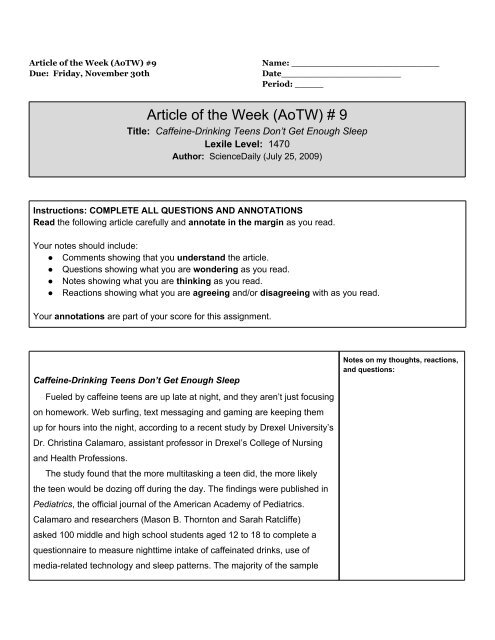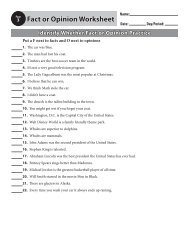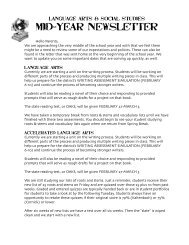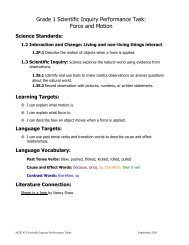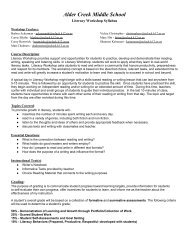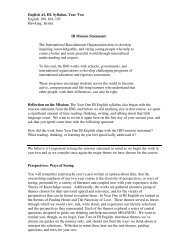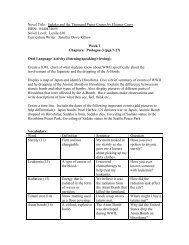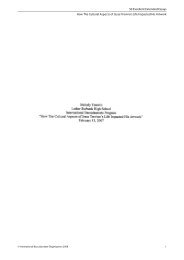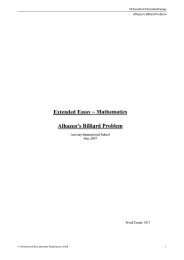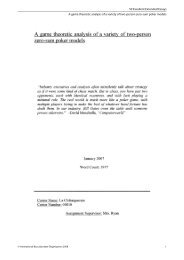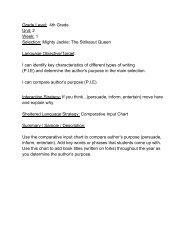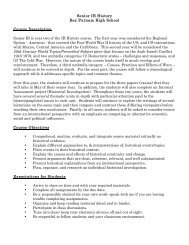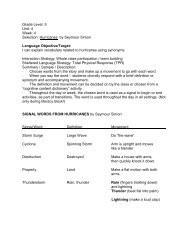Caffeine-Drinking Teens Don't Get Enough Sleep
Caffeine-Drinking Teens Don't Get Enough Sleep
Caffeine-Drinking Teens Don't Get Enough Sleep
Create successful ePaper yourself
Turn your PDF publications into a flip-book with our unique Google optimized e-Paper software.
Article of the Week (AoTW) #9<br />
Due: Friday, November 30th<br />
Name: __________________________<br />
Date_____________________<br />
Period: _____<br />
Article of the Week (AoTW) # 9<br />
Title: <strong>Caffeine</strong>-<strong>Drinking</strong> <strong>Teens</strong> Don’t <strong>Get</strong> <strong>Enough</strong> <strong>Sleep</strong><br />
Lexile Level: 1470<br />
Author: ScienceDaily (July 25, 2009)<br />
Instructions: COMPLETE ALL QUESTIONS AND ANNOTATIONS<br />
Read the following article carefully and annotate in the margin as you read.<br />
Your notes should include:<br />
● Comments showing that you understand the article.<br />
● Questions showing what you are wondering as you read.<br />
● Notes showing what you are thinking as you read.<br />
● Reactions showing what you are agreeing and/or disagreeing with as you read.<br />
Your annotations are part of your score for this assignment.<br />
<strong>Caffeine</strong>-<strong>Drinking</strong> <strong>Teens</strong> Don’t <strong>Get</strong> <strong>Enough</strong> <strong>Sleep</strong><br />
Fueled by caffeine teens are up late at night, and they aren’t just focusing<br />
on homework. Web surfing, text messaging and gaming are keeping them<br />
up for hours into the night, according to a recent study by Drexel University’s<br />
Dr. Christina Calamaro, assistant professor in Drexel’s College of Nursing<br />
and Health Professions.<br />
The study found that the more multitasking a teen did, the more likely<br />
the teen would be dozing off during the day. The findings were published in<br />
Pediatrics, the official journal of the American Academy of Pediatrics.<br />
Calamaro and researchers (Mason B. Thornton and Sarah Ratcliffe)<br />
asked 100 middle and high school students aged 12 to 18 to complete a<br />
questionnaire to measure nighttime intake of caffeinated drinks, use of<br />
media-related technology and sleep patterns. The majority of the sample<br />
Notes on my thoughts, reactions,<br />
and questions:
used some form of technology, with 66 percent having a television in their<br />
bedroom, 30 percent a computer, 90 percent a cell phone and 79 percent an<br />
MP3 digital audio player.<br />
The researchers found that 20 percent of those studied got the<br />
recommended eight or more hours of sleep during school nights with the<br />
rest getting less than eight hours. The average sleep for U.S. adolescents<br />
is seven hours, according to Calamaro. At least 30 percent of teenagers<br />
reported falling asleep during school. <strong>Caffeine</strong> consumption tended to be 76<br />
percent higher among those who fell asleep. Most teenagers used multiple<br />
electronic media late into the night and consumed a variety of caffeinated<br />
beverages, including many popular energy drinks marketed to their age<br />
group, said Calamaro.<br />
To gauge how heavily the study participants used technology at night,<br />
Calamaro and her team developed a measure they call “multitasking index.”<br />
The index took the total amount of hours a teen spent doing each of nine<br />
different activities—ranging from watching TV, listening to MP3s, watching<br />
DVDs, surfing the web and doing homework—and divided that by nine or<br />
the number of hours between 9 p.m. and 6 a.m. The index was significantly<br />
related to falling asleep during school and difficulties falling asleep on<br />
weeknights.<br />
“Many adolescents used multiple forms of technology late into the night<br />
and concurrently consumed caffeinated beverages,” said Calamaro. “Their<br />
ability to stay alert and fully functional throughout the day was impaired by<br />
excessive daytime sleepiness.”<br />
At least 85 percent of those studied reported drinking caffeine. For those,<br />
the average caffeine intake was 144 mg with a range from 23 to 1458 mg.<br />
Only 27.5 percent consumed less than 100 mg of caffeine daily or the<br />
equivalent of drinking a single espresso, whereas 11.2 percent drank more<br />
than 400 mg daily or the equivalent of four espressos.<br />
Although caffeine consumption tended to be lower for the 20 percent<br />
that slept for eight to 10 hours on a school night, it wasn’t enough to merit<br />
statistical significance. <strong>Sleep</strong> was significantly related to multitasking.<br />
Teenagers getting eight to 10 hours of sleep had lower multitasking indexes;
those getting six to eight had higher multitasking indexes. At least 33<br />
percent of the teenagers reported falling asleep at least twice during school<br />
hours.<br />
Regardless of socioeconomic status, teenagers tasked on average four<br />
activities late into the night, according to Calamaro.<br />
“Even though we know adolescents are on a different time schedule than<br />
adults, we still need to get them less wired at night,” she said. “Parents need<br />
to discourage teenagers from drinking caffeine past noon time and keep<br />
TVs, computers and especially cell phones out of kids’ bedrooms.”<br />
AoTW Question Template<br />
Use the template below to organize your responses. When the template is complete, write your responses<br />
in the form of a paper i.e. - no numbers; use paragraph indents and transition words.<br />
1. Create the Topic Sentence for Your Paper<br />
I<br />
(Identify the Item)<br />
V<br />
(Verb)<br />
F<br />
(Finish the Thought)<br />
Article #5, “ <strong>Caffeine</strong>-<strong>Drinking</strong> <strong>Teens</strong><br />
Don’t <strong>Get</strong> <strong>Enough</strong> <strong>Sleep</strong>” by Science<br />
Daily<br />
tells<br />
explains<br />
describes<br />
features<br />
provides<br />
shows<br />
illustrates<br />
presents<br />
gives<br />
addresses<br />
2. Identify the Main Idea of the Article<br />
The main idea of the article is ______________________________________________________________<br />
______________________________________________________________________________________<br />
______________________________________________________________________________________
3. Connect Your Topic Sentence and Main Idea Together to Build Paragraph #1.<br />
______________________________________________________________________________________<br />
______________________________________________________________________________________<br />
______________________________________________________________________________________<br />
______________________________________________________________________________________<br />
______________________________________________________________________________________<br />
______________________________________________________________________________________<br />
______________________________________________________________________________________<br />
4. Select a passage from the text as your “Golden Line”. Explain why you chose it and how it relates<br />
to the main idea. This will create paragraph #2.<br />
The evidence I selected as a golden line was “________________________________________________<br />
______________________________________________________________________________________<br />
______________________________________________________________________________________<br />
_____________________________________________________________________________________<br />
This passage (shows, illustrates, gives, describes, tells, explains . . .)<br />
_____________________________________________________________________________________<br />
______________________________________________________________________________________<br />
______________________________________________________________________________________<br />
_____________________________________________________________________________________<br />
5. Connection to Others or Yourself: This will create paragraph #3.<br />
Explain how this issue can relate to one’s life. (How might it relate to the lives of others or affect yours?)<br />
Sentence Starters:<br />
*The issue ______________ is important because...<br />
*This can affect other people (or me) by...<br />
*One example is...<br />
*Other people should be aware of this issue because...<br />
______________________________________________________________________________________<br />
______________________________________________________________________________________<br />
______________________________________________________________________________________<br />
______________________________________________________________________________________<br />
______________________________________________________________________________________<br />
______________________________________________________________________________________<br />
______________________________________________________________________________________<br />
______________________________________________________________________________________<br />
______________________________________________________________________________________
__________________<br />
6. Conclusion<br />
What I take away from this article is ________________________________________________________<br />
___________________________________________________________ because ________________<br />
___________________________________________________________________________________.


